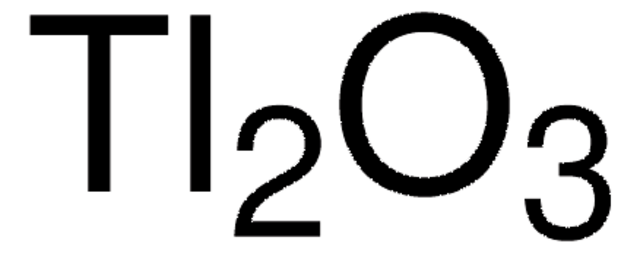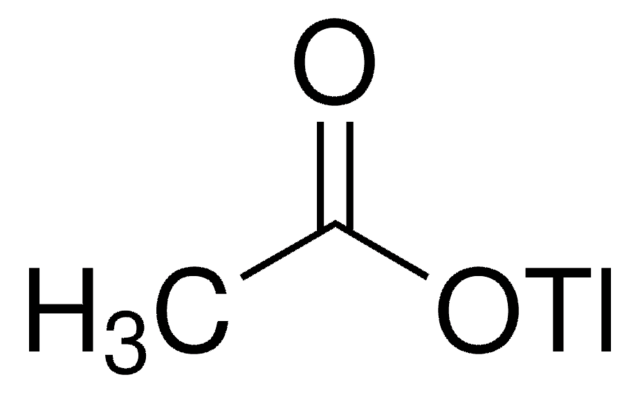309230
Thallium(I) nitrate
99.9% trace metals basis
Synonym(s):
Thallium mononitrate, Thallous nitrate
Sign Into View Organizational & Contract Pricing
All Photos(1)
About This Item
Linear Formula:
TlNO3
CAS Number:
Molecular Weight:
266.39
EC Number:
MDL number:
UNSPSC Code:
12352302
PubChem Substance ID:
NACRES:
NA.23
Recommended Products
Quality Level
Assay
99.9% trace metals basis
form
solid
solid
impurities
≤1500 mg/kg Trace metallic impurities analysis (ICP)
mp
206 °C (lit.)
SMILES string
[Tl+].[O-][N+]([O-])=O
InChI
1S/NO3.Tl/c2-1(3)4;/q-1;+1
InChI key
FYWSTUCDSVYLPV-UHFFFAOYSA-N
Looking for similar products? Visit Product Comparison Guide
General description
Thallium(I) nitrate is a white crystalline solidwith strong oxidizing properties. It is widely applied in the field of organicsynthesis, analytical chemistry, and electronics.
Application
Thallium(I) nitrate can be used:
- As an additive to synthesize thallium-containing cadmium selenide thin films by electrochemical deposition. The addition of TlNO3 decreases corrosion and helps to form uniform and stable thin films.
- As a dopant to prepare bismuth vanadate nanoparticles. TlNO3 reduces charge carrier recombination and enhances the photocatalytic activity.
- To prepare precursor solution for the detection of halogens by molecular absorption spectroscopy.
Signal Word
Danger
Hazard Statements
Precautionary Statements
Hazard Classifications
Acute Tox. 2 Inhalation - Acute Tox. 2 Oral - Aquatic Chronic 2 - Ox. Sol. 3 - STOT RE 2
Storage Class Code
5.1B - Oxidizing hazardous materials
WGK
WGK 3
Personal Protective Equipment
dust mask type N95 (US), Eyeshields, Gloves
Choose from one of the most recent versions:
Already Own This Product?
Find documentation for the products that you have recently purchased in the Document Library.
Customers Also Viewed
Determination of bromine and fluorine via sequential vaporization of TlBr and CaF molecules from the same aliquot by high-resolution continuum source graphite furnace molecular absorption spectrometry
Amauri P.A. Rosa and Tatiane de A. Maranh?o},
Spectrochimica Acta. Part B: Atomic Spectroscopy, 197, 106525-106525 (2022)
A Salinas-Castillo et al.
Analytical and bioanalytical chemistry, 376(7), 1111-1114 (2003-06-28)
The applicability of heavy atom-induced room-temperature phosphorescence to pharmaceutical samples is demonstrated in this work. Thus a new, simple, rapid, and selective phosphorimetric method for dipyridamole determination is proposed. The phosphorescence signals are a consequence of intermolecular protection when analytes
P Thanigaimalai et al.
Bioorganic & medicinal chemistry, 18(12), 4441-4445 (2010-05-18)
The oxidative cyclization of 2'-hydroxy-6'-cyclohexylmethoxychalcones 5 using thallium (III) nitrate (TTN) in alcoholic solvents produced isoflavones 2 and (or) aurones 3 depending on the electronic nature of p-substituents on ring B. Chalcones with strong electron donating substituents (OH, OCH(3)) were
Vânia M T Carneiro et al.
The Journal of organic chemistry, 75(9), 2877-2882 (2010-04-10)
A diastereoselective route to (+)-bakkenolide A is presented from the readily available optically active Wieland-Miescher ketone. This novel synthesis of this sesquiterpene lactone features the following as key stereoselective transformations: (i) the ring contraction reaction of a octalone mediated by
Cecilia Eliana Hanzel et al.
Toxicology and applied pharmacology, 236(1), 59-70 (2009-04-18)
Thallium (Tl) is a highly toxic metal though yet its mechanisms are poorly understood. Previously, we demonstrated that rat pheochromocytoma (PC12) cells exposure to thallous (Tl(I)) or thallic (Tl(III)) cations leads to mitochondrial damage and reduced cell viability. In the
Our team of scientists has experience in all areas of research including Life Science, Material Science, Chemical Synthesis, Chromatography, Analytical and many others.
Contact Technical Service














